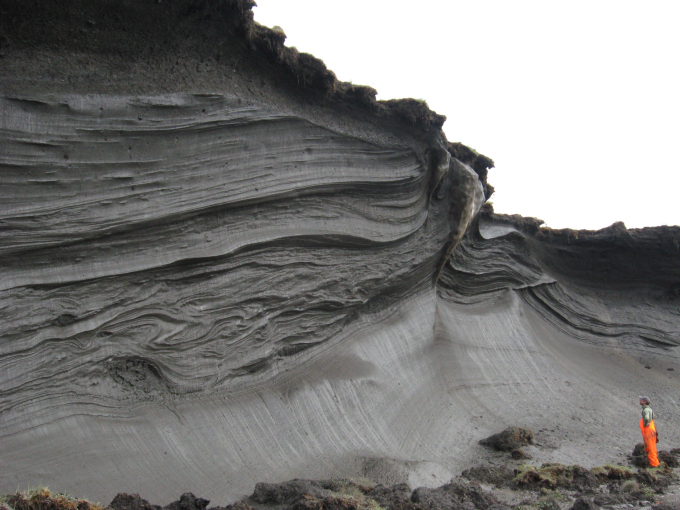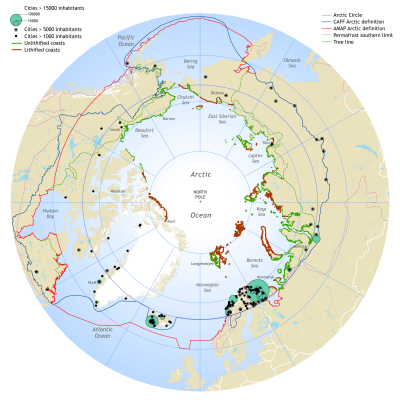Arctic coasts on the retreat
The coastline in Arctic regions reacts to climate change with increased erosion and retreats by half a metre per year on average. This means substantial changes for Arctic ecosystems near the coast and the population living there. A consortium of more than thirty scientists from ten countries, including researchers from the Alfred Wegener Institute for Polar and Marine Research in the Helmholtz Association and from the Helmholtz-Zentrum Geesthacht, comes to this conclusion in two studies published in Estuaries and Coasts and online on www.arcticcoasts.org. They jointly investigated over 100,000 kilometres and thus a fourth of all Arctic coasts and their results have now been published for the first time.

Since around a third of the world’s coasts are located in the Arctic permafrost, coastal erosion may affect enormous areas in future. Photo: AWI
The changes are particularly dramatic in the Laptev, East Siberian and Beaufort Seas, where coastal erosion rates reach more than 8 metres a year in some cases. Since around a third of the world’s coasts are located in the Arctic permafrost, coastal erosion may affect enormous areas in future. In general Arctic coasts react more sensitively to global warming than coasts in the mid-latitudes. Up to now they have been protected against the eroding force of the waves by large sea ice areas. Due to the continuous decline in sea ice, this protection is jeopardised and we have to reckon with rapid changes in a situation that has remained stable for millennia.
Two thirds of the Arctic coasts do not consist of rock, but of frozen soft substrate (permafrost). And precisely these coasts are extremely hard hit by erosion. As a rule, Arctic regions are quite thinly populated. However, as nearly everywhere in the world, the coasts in the far north are important axes for economic and social life. The growing need for global energy resources as well as increasing tourism and freight transport additionally intensify anthropogenic influence on the coastal regions of the Arctic. For wild animal stocks, like the great caribou herds of the north, and the widespread freshwater lakes near the coast progressive erosion brings about significant changes in ecological conditions.
Successful cooperation

A large part of the Arctic coasts consists of unslit sediments that are susceptible to erosion when in contact with incoming waves. Two thirds of the Arctic coasts are not rocky but consist of frozen soft substrate (permafrost) and are therefore particularly affected by erosion. Map by Hugues Lantuit, Alfred Wegener Institute.
More than thirty scientists from ten countries were involved in preparing the 170-page status report entitled “State of the Arctic Coast 2010”. The study was initiated and coordinated by the International Arctic Science Committee (IASC), the international joint project Land-Ocean Interactions in the Coastal Zone (LOICZ), the International Permafrost Association (IPA) and the Arctic Monitoring and Assessment Programme (AMAP) working group of the Arctic Council.
“This international and interdisciplinary report documents in particular the interest and expertise of German scientists in the field of Arctic coastal research,” says Dr. Volker Rachold, Executive Secretary of the IASC. “Three of the international organisations involved in the report are based in Germany. The secretariats of the IASC and IPA are located at the Potsdam Research Unit of the Alfred Wegener Institute for Polar and Marine Research in the Helmholtz Association (AWI). The international coordination office of the LOICZ project is funded by the Helmholtz-Zentrum Geesthacht (HZG) and has its domicile there at the Institute of Coastal Research. Among other things, researchers see the current study as an international and national contribution to the joint research programme of the Helmholtz Association “Polar Regions and Coasts in a Changing Earth System” (PACES), which is supported by the Alfred Wegener Institute and the Helmholtz Centre in Geesthacht.
“When systematic data acquisition began in 2000, detailed information was available for barely 0.5% of the Arctic coasts,” says Dr. Hugues Lantuit from the Alfred Wegener Institute (AWI). At the same time the geologist from AWI’s Potsdam Research Unit heads the international secretariat of the IPA and is also one of the coordinators of the study. After over ten years of intensive work we have now gained a comprehensive overview of the state and risk of erosion in these areas. “The Arctic is developing more and more into a mirror of various drivers of global change and into a focal point of national and worldwide economic interest,” says Dr. Hartwig Kremer, head of the LOICZ project office.
